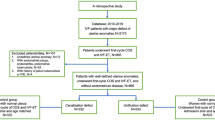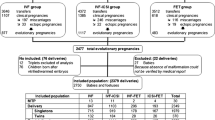Abstract
Background
Intracytoplasmic sperm injection (ICSI) procedures have become accepted worldwide and their effect on society is well-known. However, the full extent of the possible complications of these procedures on maternal and neonatal outcome is still unclear.
Materials and Methods
This is a retrospective case controlled study from January 2003 to December 2007 which compared 253 women that had conceived using assisted reproduction (ICSI) and delivered 327 children at our center (study group) with a matched group of 349 women who naturally conceived and delivered 354 children at Abha General Hospital (control group) during the same period. The obstetrical and neonatal characteristics of the women and their children were assessed to determine any significant differences between the groups.
Results
The number of gestations per pregnancy (1.34 ± 0.57 vs. 1.01 ± 0.12) and number of children born per woman (1.28 ± 0.49 vs. 1.01 ± 0.12) was significantly higher in the ICSI group (p < 0.001). In addition, the gestational age at delivery (37.23 ± 2.68 vs. 38.56 ± 1.89) was significantly shorter in the ICSI group (p < 0.001) and this led to an increased number of obstetrical interventions, as well as the incidence of cesarean deliveries. Examination of the new-born children revealed similar incidence of congenital anomalies in both groups.
Conclusion
ICSI conceived pregnancies were characterized by an increased number of gestations and live-born, and there was no increase in congenital malformations compared to naturally conceived pregnancies.
Similar content being viewed by others
References
Steptoe PC, Edwards RG. Birth after the reimplantation of a human embryo. Lancet. 1978;2(8085):366.
Palermo G, Joris H, Devroey P, Van Steirteghem AC. Pregnancies after intracytoplasmic injection of single spermatozoon into an oocyte. Lancet. 1992;340(8810):17–8.
Brinton L. Long-term effects of ovulation-stimulating drugs on cancer risk. Reprod Biomed Online. 2007;15(1):38–44.
Chung K, Coutifaris C, Chalian R, Lin K, Ratcliffe SJ, Castelbaum AJ, et al. Factors influencing adverse perinatal outcomes in pregnancies achieved through use of in vitro fertilization. Fertil Steril. 2006;86(6):1634–41.
Intracytoplasmic sperm injection (ICSI) in 2006: evidence and evolution. Hum Reprod Update 2007;13(6):515–26.
Aboulghar MA. Perinatal complications of assisted reproduction. Croat Med J. 2005;46(5):751–8.
Thomson F, Shanbhag S, Templeton A, Bhattacharya S. Obstetric outcome in women with subfertility. BJOG. 2005;112(5):632–7.
Basso O, Baird DD. Infertility and preterm delivery, birthweight, and Caesarean section: a study within the Danish National Birth Cohort. Hum Reprod. 2003;18(11):2478–84.
Henriksen TB, Baird DD, Olsen J, Hedegaard M, Secher NJ, Wilcox AJ. Time to pregnancy and preterm delivery. Obstet Gynecol. 1997;89(4):594–9.
Draper ES, Kurinczuk JJ, Abrams KR, Clarke M. Assessment of separate contributions to perinatal mortality of infertility history and treatment: a case-control analysis. Lancet. 1999;353(9166):1746–9.
Aboulghar H, Aboulghar M, Mansour R, Serour G, Amin Y, Al-Inany H. A prospective controlled study of karyotyping for 430 consecutive babies conceived through intracytoplasmic sperm injection. Fertil Steril. 2001;76(2):249–53.
Bonduelle M, Aytoz A, Van AE, Devroey P, Liebaers I, Van SA. Incidence of chromosomal aberrations in children born after assisted reproduction through intracytoplasmic sperm injection. Hum Reprod. 1998;13(4):781–2.
Eskandar M, Abou-Setta AM, Almushait MA, El-Amin M, Mohmad SE. Ultrasound guidance during embryo transfer: a prospective, single-operator, randomized, controlled trial. Fertil Steril. 2008;90(4):1187–90.
Thurin A, Hausken J, Hillensjo T, Jablonowska B, Pinborg A, Strandell A, et al. Elective single-embryo transfer versus double-embryo transfer in in vitro fertilization. N Engl J Med. 2004;351(23):2392–402.
Papanikolaou EG, Camus M, Kolibianakis EM, Van LL, Van SA, Devroey P. In vitro fertilization with single blastocyst-stage versus single cleavage-stage embryos. N Engl J Med. 2006;354(11):1139–46.
Poikkeus P, Tiitinen A. Does single embryo transfer improve the obstetric and neonatal outcome of singleton pregnancy? Acta Obstet Gynecol Scand. 2008;87(9):888–92.
Scotland GS, McNamee P, Peddie VL, Bhattacharya S. Safety versus success in elective single embryo transfer: women’s preferences for outcomes of in vitro fertilisation. BJOG. 2007;114(8):977–83.
Gleicher N, Barad D. Twin pregnancy, contrary to consensus, is a desirable outcome in infertility. Fertil Steril. 2009;91(6):2426–31.
Hansen M, Kurinczuk JJ, Bower C, Webb S. The risk of major birth defects after intracytoplasmic sperm injection and in vitro fertilization. N Engl J Med. 2002;346(10):725–30.
Allen C, Bowdin S, Harrison RF, Sutcliffe AG, Brueton L, Kirby G, et al. Pregnancy and perinatal outcomes after assisted reproduction: a comparative study. Ir J Med Sci. 2008;177(3):233–41.
Hansen M, Bower C, Milne E, de Klerk N, Kurinczuk JJ. Assisted reproductive technologies and the risk of birth defects—a systematic review. Hum Reprod. 2005;20(2):328–38.
Romundstad LB, Romundstad PR, Sunde A, von During V, Skjaerven R, Gunnell D, et al. Effects of technology or maternal factors on perinatal outcome after assisted fertilisation: a population-based cohort study. Lancet. 2008;372(9640):737–43.
Sutcliffe AG, Saunders K, McLachlan R, Taylor B, Edwards P, Grudzinskas G, et al. A retrospective case-control study of developmental and other outcomes in a cohort of Australian children conceived by intracytoplasmic sperm injection compared with a similar group in the United Kingdom. Fertil Steril. 2003;79(3):512–6.
Ombelet W, Peeraer K, De SP, Gerris J, Bosmans E, Martens G, et al. Perinatal outcome of ICSI pregnancies compared with a matched group of natural conception pregnancies in Flanders (Belgium): a cohort study. Reprod Biomed Online. 2005;11(2):244–53.
Author information
Authors and Affiliations
Corresponding author
Rights and permissions
About this article
Cite this article
Al-Fifi, S., Al-Binali, A., Al-Shahrani, M. et al. Congenital anomalies and other perinatal outcomes in ICSI vs. naturally conceived pregnancies: a comparative study. J Assist Reprod Genet 26, 377–381 (2009). https://doi.org/10.1007/s10815-009-9329-3
Received:
Accepted:
Published:
Issue Date:
DOI: https://doi.org/10.1007/s10815-009-9329-3




